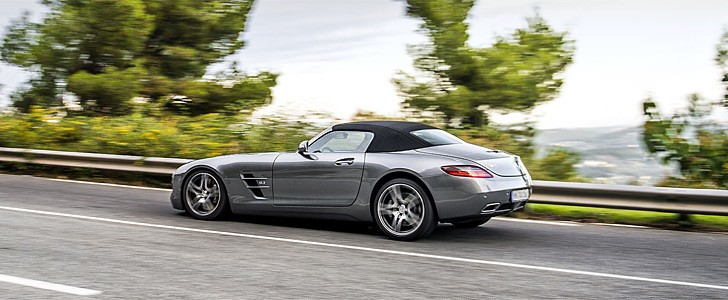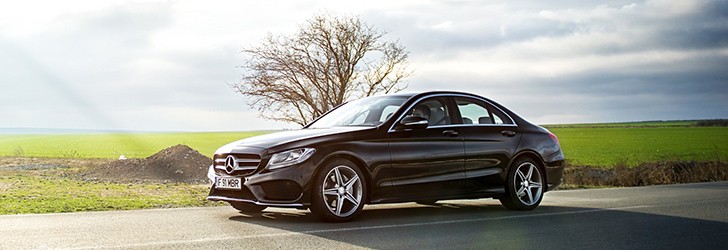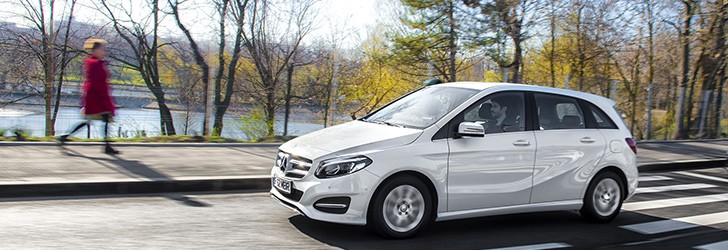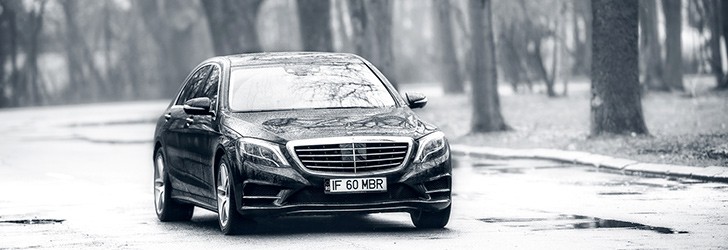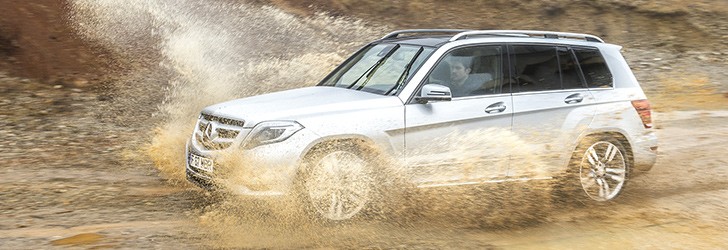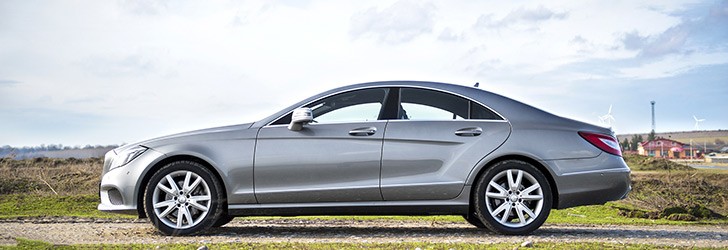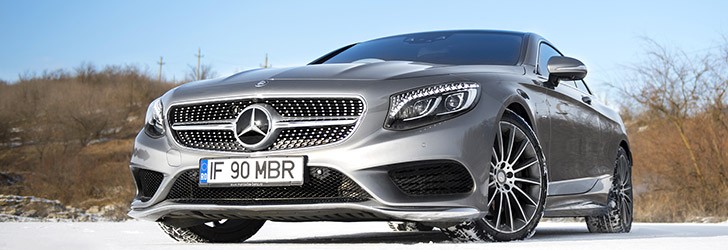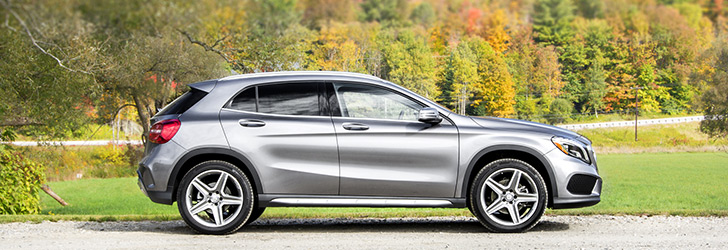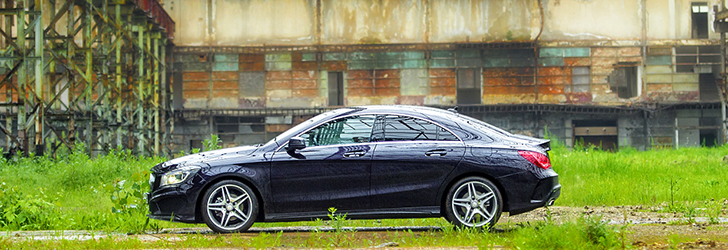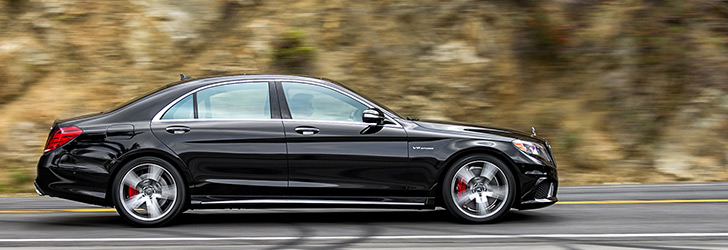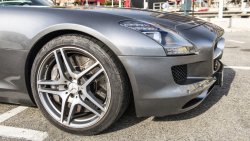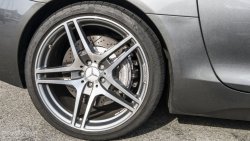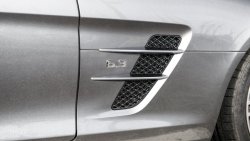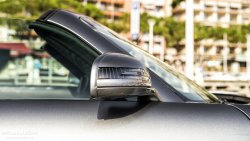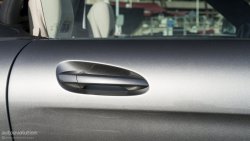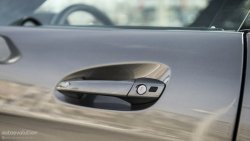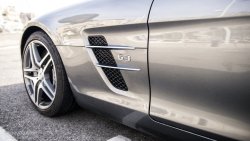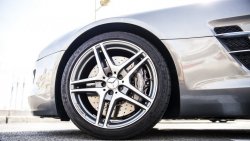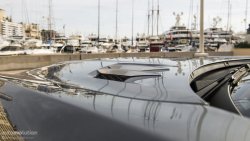MERCEDES-BENZ SLS AMG Roadster Review
OUR TEST CAR: MERCEDES-BENZ SLS AMG Roadster 2012
Since the SLS is the fastest production car that the automaker has ever placed its badge on, you would imagine that in terms of comfort it is as far from a Mercedes saloon as the cargo area of a Sprinter van, but you’d be wrong.
While the SLS doesn’t take playing on the track too serious, even though it can act this way, when it comes to providing coziness, it is about as serious as a car with this level of performance can be.
The standard, passive suspension on our test car was firm, but not past that point which makes it becomes memorable in a negative way after you end a driving session and while the seats seemed to have the same kind of personality at first, we found them rather pleasant after a few hours spent inside the car.
We must’ve mentioned the fact that driving the SLS Roadster with the top folded can easily become an addiction about a billion times now, but what about the moments when the weather, the company, or simply the moment, requires you to place the soft top over your head?
The three layers of the roof provide enough soundproofing to allow you to use all the speedometer’s travel for as many hours as you like and the part that is closer to you perfectly mimics the roofliner of a coupe, so visual comfort is present too.
Since this is a Mercedes, even the navigation - Navteq maps, to be more precise - is intuitive and totally relibable, so, frankly, when you drive the SLS Roadster, everything is there to keep one relaxed.
Mercedes wanted to make sure that you can enjoy this finesse of the SLS, so it placed a 99-liter (26.15 gallons) tank inside the car, which mixed with the reasonable fuel efficiency of the powerplant, gives you that piece of mind called autonomy, which you need for long trips, an asset that’s not all that frequent when talking about cars with this much power.
So, how comfortable did the SLS Roadster make us feel in terms of avoiding the pump? A full-throttle drive at high altitude showed a 30l/100 km or 7.8 mpg value, but when we used a normal cruising style with occasional accelerator pedal dips, the value dropped to half of the aforementioned amount.
What does the SLS do to justify the “Controlled Efficiency” name of its softest powertrain mode? Well, even though the car doesn’t advertise this, its engine is packed with solutions that are meant to increase efficiency.
It all starts at the core of the engine, the combustion chamber, where AMG offers an unique low internal friction technology, which it describes as a friction-optimized twin-wire arc-sprayed coating on the cylinder walls. But a powerplant also needs lubrication and since they built a special dry-sump system for the SLS’ engine, this tries to save energy be working on demand. Further down the power-producing process, the alternator also works as a generator that feeds electrical current into the battery during the engine overrun phase.
We’re sorry for the not-so-short- technical interference - this car is so overengineered, in a good way, of course, that we just couldn’t help ourselves.
Both the Coupe and the Roadster use an all-aluminum chassis and body (these form the aluminum spaceframe of the car), with steel only being present in a very small proportion (in the windshield frame) due to the need for extra strength. Having the wind in your hair will cost you an extra 40 kg (88 lbs) compared to the coupe, which brings the SLS Roadster to 1660 kg (3,661 lbs). As an interesting fact, this is about the same weight difference as the one between the original 1950s 300SL and 300SL Roadster.
Since the SLS was a project developed by AMG engineers, they were obsessed with keeping the weight down. While for the Coupe this meant that the Gulling doors are not power assisted, in the case of the Roadster, they decided to leave out the usual technical solution for bringing the NVH (noise, vibration and harshness) level of an open-top vehicle down, so vibration dampers are not present. What they did to reduce the NVH level, and to strengthen the body so that the car feels pleasant to drive, was to work on the aluminum spaceframe.
The sideskirts have thicker walls with extra chambers, there are more struts that support the dashboard cross-member against the center tunnel and the windshield, while at the back, we have a curved strut that runs from the canvas top to the fuel tank in order to reinforce the rear axle.
Behind the seats there is a reinforcing crossmember that joins forces with the fixed rollbars, which is also where the 250 watt subwoofer of the optional Bang & Olufsen BeoSound AMG audio system is hidden.
In the end, the aluminum spaceframe of the Roadster sits at 243 kg (536 lbs), weighing only 2 kg (4.5 lbs) more than that of the Coupe, with the rest of the weight difference between the two coming from the roof mechanism.
Aluminum, forged aluminum to be more precise, was also used for the suspension, where the diet didn't only bring overall but also unsprung mass reduction. The SLS has a double wishbone configuration (with a tie rod) at each corner, a solution borrowed from the racetrack.
The launch of the Roadster saw the introduction of an optional Adaptive AMG Sports Suspension, a feature that will also be offered on the Coupe, but wasn't present on our test car.
The idea of keeping the weight down applies both figuratively and literally and to cover the latter, the steering gear was mounted in front of the engine, on the integral subframe, so that the generously-sized V8 could be placed lower.
The automaker also studied the force paths developed in the body during aggressive driving and it placed the connections between the passenger cell and the front and rear sections at just the right places, but as low as possible. We also have transverse reinforcing struts located at the front and rear axles, which have been included in the bodyshell.
We mention the SLS's powerplant earlier - what a naturally-aspirated V8 this car has! The engine is marketed as "6.3" despite its 6,208 cc displacement to to remember us of the M100, Merc's first production V8, which actually offered 6.3 liters.
You might be familiar with the name from the rest of the AMG range, as the unit is being used from the C-Class upwards, but there's a detail that changes everything here. The aforementioned models use the M156 6.3 engine, the first unit to be developed from the ground up by AMG, but the specialists in Affalterbach tweaked this for the SLS, turning it into the M159.
While the M156 is offered in multiple outputs that go up to 525 hp and 630 Nm (465 lb-ft), or even 650 Nm (480 lb-ft) in the case of the limited edition C63 AMG DR 520, the SLS' M159 offers 571 hp and 650 Nm.
To convince the new horses to step into the stable, the engineers had to make sustained efforts. Had this been a forced induction unit, they could've put in beefier turbochargers, upgrade the internals and the cooling systems so that they face the new challenges and call it a day. But the M159 is a naturally-aspirated unit and also one that's already based on an engine that was taken far down the performance road from its inception, since the latter is AMG's first "in-house" creation.
The work started at the entry point of the tunnel, the air intake, then moved on to the valve train and camshafts. The specialists also replaced the exhaust headers with ones that allow a better gas flow,"de-throttled" the exhaust and even changed the bearings of the crankshaft.
The final piece was a dry-sump lubrication system, which brings two advantages. It reduced the height of the engine, so, since its lower side, where the oil pan is usually found, dissapears, the powerplant can be mounted lower. In addition to that, the system offers an even better lubrication during high-speed cornering.
Once the powerplant was completed, the checklist was given a look and new powertrain Inspiration came from the C-Class, but not your showroom car, we are talking about the DTM racer, with the result being called torque tube. This is basically a solid link between the engine and the transaxle gearbox (this is palced at the rear of the car). To be more specific, they used a carbon fiber drive shaft inside an aluminum housing to send the power from the engine up front to the gearbox at the back of the car.
The torque tube is linked to a Speedshift DCT transmission, as AMG calls it. In English, this is a dual-clutch transaxle coming from Getrag. The same unit can be found in the Ferrari California and while the Prancing Horse, with its usual attitude, doesn't offer the shifting times, AMG tells us that the shifts take 100ms.The transmission housing also integrates a mechanical multi-disc limited-slip differential.
Despite the tons of engineering and electronics that went into this car, you don't get an artificial sensation when you drive it, with the exception of the times when you push it too hard and the ESP steps in to show both the oversteer, and you, who's boss.
You simplu cannot fit a car like the SLS AMG with any gadgets that can outshine its mechanical assets and while we already covered these in the "Tech Facts" chapter, we forgot to tell you one thing.
We didn't explain who Hans-Werner Aufrecht is. The German, together with a second Mercedes engineer, Erhard Melcher, are the people who founded Aufrecht Melcher Großaspach (that is correct, AMG). Hans-Werner Aufrecht is also the man behind HWA, Mercedes' racing team that handles the DTM Mercedes-AMG factory team. Why did we mention this? It simple: the SLS is the first car in the history of AMG that was created by Merc's performance division from scratch, rather than being based on a Mercedes vehicle, with HWA also bringing a contribution to this, such as the “torque tube” DTM-like concept.
But the SLS is a Grand Tourer, it has to cover all this technical complexity in multiple layers that are meant to interact with the human beings found inside the car. When the Roadster was introduced, it had to come up with something that made it better than the Coupe in terms of infotainment and this role went to the AMG Performance Media. This is the car’s way of making conversation. You simply press the AMG button and then you can navigate through the menus using the COMAND Controller.
And you'll find out that the SLS Roadster has quite a special vocabulary. It knows how to talk to you about engine and transmission fluids temperature, engine output and throttle position, it also whispers tire pressures and, in addition to that, it can be a very good listener. The system will record your 0 to 60 mph or 0-100 km/h times, as well as various laptimes. Aside from that, the SLS Roadster also has a good memory, as it can save your data, just in case you want to remember what you did with the car the other day.
This is a trend on the market, you can find similar performance monitoring systems in cars that cost almost ten times as little as a fully loaded SLS, albeit in a lesser form and yet there are more expensive go-fast machines that don't come with such a feature. It's a fun toy, but the typical SLS buyer will probably only used it once. OK, once per year, which is probably why we don't have a problem with the fact that it's an optional feature.
It's interesting to see how the Germans were Germans even when it came to the Dutch, as they went so far with the engineering that the subwoofer of the optional Bang & Olufsen BeoSound AMG surround sound system was housed inside the reinforcing crossmember which supports the roll protection elements behind the seats. However, the carmaker didn't bring its usual approach in terms of the suspension, as it didn't give us a nose-lift system, with customers having to turn to the tuning scene for such a feature.
Now that we've indulged ourselves in optional features, it's time to also mention the standard ones. These vary from the simple but efficient. Airscarf system, which allows you to enjoy the deep growl of the exhaust even when the weather wants to keep you from doing that, to the COMAND infotainment system that integrates the navigation system, as well as a DVD player.
Just like in the case of the Blind Spot Monitoring system we mentioned in the "Safety"chapter, and the parking sensors & rear-view camera from the "City" chapter, the fact that the car is built by Mercedes brings extra benefits, as these people are not joking when it comes to navigation systems. Yes,there will be some who'll tease you by telling you that the satnav on you SLS looks like that on your father's [insert name of Mercedes model you'd buy for your dad here], but in the real world this means that you get a very intuitive and helpful system.
Once the elements in the foreground are taken care of, make sure you spend a reasonable amount of time to also take care of the background. You can choose from the nine exterior finishes, three soft top shades and eight interior colors and while the carbon fiber aroma for the cabin is a matter of choice, we'd recommend you to go for the extended leather package, which basically brings the material to all the relevant surfaces inside the car.
Mercedes itself tells us that “Virtually no other area inspires the Mercedes-Benz engineers to produce such consistently impressive results as much as research into new safety technologies” and, as you can imagine, this obsession for keeping things under control has also left a positive mark on the SLS.
The sporting principles on which the SLS was built make the car even safer and this is amplified in the case of the Roadster. The open-top experience allows one to enjoy the repertoire of the exhaust even more and during the time spent with the car, we often found ourselves in the Controlled Efficiency driving mode, as the softer powertrain settings it uses allows you to increase the revs without surging forward and creating a potentially dangerous situation. The Grand Tourer character of the SLS allows you to enjoy the ride at virtually any speed.
The safety element of the SLS that we enjoyed the most was the Blind Spot Assist, a standard feature. This kind of cars don’t usually come which such system, despite the fact that the poor visibility is a common issue for the genre. You’re never going to drive placing your life in its hands, but the reassuring feeling you get when by having it during a multi-lane drive is unique, it basically keeps you relaxed so you can enjoy the car more without having to turn to horsepower use to achieve pleasure.
It’s also pleasant to know that even though the rain affects grip, it won’t cripple any of your brake response time, since the Adaptive Brake system the car is fitted with includes a brake drying function that brings the brake pads close to the rotors without you even noticing this.
The ESP has three modes: “On” “Sport” and “Off”, but even when using the last one, the ASR (acceleration skid control) is there to brake the wheel that looses traction, thus helping the mechanical limited slip differential keep the car on track. Like we said, the ESP can be turned off and you can allow the back end to step out, but once you touch the brake pedal it automatically reactivates itself. And if you keep the ESP fully On and have a dry road at your disposal, you can push the car as hard as you like and it won’t show signs of oversteer.
The SLS Roadster can cocoon you in eight airbags. There are two adaptive frontal airbags, kneebags for both occupants, the seats house two side airbags and the heads of the driver and passenger are treated with two dedicated airbags.
As we wrote in the Tech facts chapter, the aluminum spaceframe of the SLS Roadster features an array of reinforcements which are not just there to keep normal drivers from telling the difference in rigidity between the Coupe and the Roadster, but also to minimize the consequences of an impact.
For example, the Roadster comes with two fixed rollbars placed behind the headrests, which are supported by a reinforcing crossmember, while the crossmember behind the dashboard usses additional struts (compared to the Coupe) for the support against the center tunnel and the windshield frame, which is made of stronger, heat-formed steel.
Mercedes’ dedication to safety literally goes all they way up to the screws. For example, the system that attaches the drivetrain of the car to the aluminum spaceframe tightens the screws we are talking about at a gentle pace, using movements that inspire assembly rigidity.
From the first moment you meet it, the SLS gives you a feeling of familiarity, one that’s amplified in the Roadster form and this is because it shows a striking resemblance to American sports cars in the way its proportioned, it looks and it goes when you’ve got a long, straight road in front of you. Well, like we said in the “Intro” chapter, this is no coincidence, as its spiritual predecessor,. the 300SL, basically made the journey from the track to the road for American customers. It was also the car that changed the way in which US customers saw the brand, which had never been associated with sporting credentials until its arrival.
Researchers tell us that cold is the strongest sensation the human body can experience, but they’re wrong - the SLS Roadster easily convinces you to keep the top folded even when the temperature outside begs to differ. And it’s definitely not the Airscarf that caresses your neck with warm air which convinces you to do that- you can have this feature in an SLK but it doesn’t act this way. It’s the car altogether, the engine's eagerness to deliver its torque, the view offered by the bonnet, the way the flat-bottomed steering wheel and the gearshift paddles feel, everything this car has to offer feels so good that you just can’t say no to amplifying the feeling by driving with the top down. The car is also one of the most comfortable convertibles we've driven, thanks to the excellent wind protection and complex roof that protects you from the elements in a superior way.
However, before anything else, the SLS is a Grand Tourer, one that can be used as a definition of the species. It can battle supercars both on the street and on the track, but its main asset is that it makes you choose the longer route whenever you have to go somewhere. 60 years ago, the 300SL was the first production car to use direct injection, but we suspect that the SLS comes with a hidden carburetor, one that mixes good times behind the wheel with refinement and an impressive amount of comfort. If convincing all navigation system producers to introduce an option called “the SLS route”, one that chooses the best driving road to your destination, would be too much, at least the Navteq maps on the SLS should offer this option.
At the heart of the €195,160 ($196,100 if you live in the US) SLS, we find a hand-built 6.2-liter V8 engine - the unit in our test car was put together by a specialist named Denis, whom we’d like to thank for doing an excellent job. The powerplant doesn’t just provide enough torque and power for every kind of occasion you can think of, but it also offers an asset which is so entertaining that it makes us sad. We’re referring to the immediate response and linearity of a naturally-aspirated engine, characteristics that we may never receive in the turbocharged engine that most carmakers, including AMG, seem to be switching to in their pursue for superior efficiency. You don’t even have to pay attention to these pleasant aspects in order to notice them, as they're constantly highlighted by the voice of the god that's disguised as an exhaust system.
We shouldn’t avoid comparing this GT with supercars, as there are many who want to receive such answers so we won’t. The SLS might not feel exactly as focused as these machines at the limit, but its much more versatile, it can actually be used inside the city and, if, unlike the typical SLS buyers, you’re really that much into G forces and slip angles, you can get the sharper GT version or wait for Mercedes to release the SLS Black Series, a car that will make a Ferrari 458 Italia run for its life on the Nurburgring. But the bottom line is that the “standard” SLS, if we can call it this way, pushes all the right buttons for its target audience.
And if you want to know why we gave it 9 out of 10 points for this chapter, it's because the SLS makes you choose between the setup of the Coupe, which comes with Gullwing doors that draw to much attention for our everyday driving taste, and that of the Roadster, which may have a well-engineered soft top, but still doesn't offer 100 percent of the peace and quiet of a fixed metallic roof.
The SLS Roadster is not a fallen angel that has lost its gullwings in the decadence process, it has a spirit of its own, ones that redefines the word "charm".
Charisma? It’s got so much that this spills outside the car and reaches those around you. Mercedes fitted it with a 99-liter (26.15 gallons) fuel tank so that it stays true to its GT character, but, during our test drive, we somehow managed to reach an area where the gas stations are closed at night at the precise moment that we really needed a pump. We noticed that there was still somebody inside the petrol station and when we went to talk to the man, he apologized, telling us that everything was closed. However, at a certain moment during the conversation, he noticed the SLS Roadster sitting there quietly. It was at that point that his facial expression suddenly changed into a smile and, a few minutes later, the tank was brimmed.
While the SLS doesn’t take playing on the track too serious, even though it can act this way, when it comes to providing coziness, it is about as serious as a car with this level of performance can be.
The standard, passive suspension on our test car was firm, but not past that point which makes it becomes memorable in a negative way after you end a driving session and while the seats seemed to have the same kind of personality at first, we found them rather pleasant after a few hours spent inside the car.
We must’ve mentioned the fact that driving the SLS Roadster with the top folded can easily become an addiction about a billion times now, but what about the moments when the weather, the company, or simply the moment, requires you to place the soft top over your head?
The three layers of the roof provide enough soundproofing to allow you to use all the speedometer’s travel for as many hours as you like and the part that is closer to you perfectly mimics the roofliner of a coupe, so visual comfort is present too.
Since this is a Mercedes, even the navigation - Navteq maps, to be more precise - is intuitive and totally relibable, so, frankly, when you drive the SLS Roadster, everything is there to keep one relaxed.
Mercedes wanted to make sure that you can enjoy this finesse of the SLS, so it placed a 99-liter (26.15 gallons) tank inside the car, which mixed with the reasonable fuel efficiency of the powerplant, gives you that piece of mind called autonomy, which you need for long trips, an asset that’s not all that frequent when talking about cars with this much power.
So, how comfortable did the SLS Roadster make us feel in terms of avoiding the pump? A full-throttle drive at high altitude showed a 30l/100 km or 7.8 mpg value, but when we used a normal cruising style with occasional accelerator pedal dips, the value dropped to half of the aforementioned amount.
What does the SLS do to justify the “Controlled Efficiency” name of its softest powertrain mode? Well, even though the car doesn’t advertise this, its engine is packed with solutions that are meant to increase efficiency.
It all starts at the core of the engine, the combustion chamber, where AMG offers an unique low internal friction technology, which it describes as a friction-optimized twin-wire arc-sprayed coating on the cylinder walls. But a powerplant also needs lubrication and since they built a special dry-sump system for the SLS’ engine, this tries to save energy be working on demand. Further down the power-producing process, the alternator also works as a generator that feeds electrical current into the battery during the engine overrun phase.
We’re sorry for the not-so-short- technical interference - this car is so overengineered, in a good way, of course, that we just couldn’t help ourselves.
Both the Coupe and the Roadster use an all-aluminum chassis and body (these form the aluminum spaceframe of the car), with steel only being present in a very small proportion (in the windshield frame) due to the need for extra strength. Having the wind in your hair will cost you an extra 40 kg (88 lbs) compared to the coupe, which brings the SLS Roadster to 1660 kg (3,661 lbs). As an interesting fact, this is about the same weight difference as the one between the original 1950s 300SL and 300SL Roadster.
Since the SLS was a project developed by AMG engineers, they were obsessed with keeping the weight down. While for the Coupe this meant that the Gulling doors are not power assisted, in the case of the Roadster, they decided to leave out the usual technical solution for bringing the NVH (noise, vibration and harshness) level of an open-top vehicle down, so vibration dampers are not present. What they did to reduce the NVH level, and to strengthen the body so that the car feels pleasant to drive, was to work on the aluminum spaceframe.
The sideskirts have thicker walls with extra chambers, there are more struts that support the dashboard cross-member against the center tunnel and the windshield, while at the back, we have a curved strut that runs from the canvas top to the fuel tank in order to reinforce the rear axle.
Behind the seats there is a reinforcing crossmember that joins forces with the fixed rollbars, which is also where the 250 watt subwoofer of the optional Bang & Olufsen BeoSound AMG audio system is hidden.
In the end, the aluminum spaceframe of the Roadster sits at 243 kg (536 lbs), weighing only 2 kg (4.5 lbs) more than that of the Coupe, with the rest of the weight difference between the two coming from the roof mechanism.
Aluminum, forged aluminum to be more precise, was also used for the suspension, where the diet didn't only bring overall but also unsprung mass reduction. The SLS has a double wishbone configuration (with a tie rod) at each corner, a solution borrowed from the racetrack.
The launch of the Roadster saw the introduction of an optional Adaptive AMG Sports Suspension, a feature that will also be offered on the Coupe, but wasn't present on our test car.
The idea of keeping the weight down applies both figuratively and literally and to cover the latter, the steering gear was mounted in front of the engine, on the integral subframe, so that the generously-sized V8 could be placed lower.
The automaker also studied the force paths developed in the body during aggressive driving and it placed the connections between the passenger cell and the front and rear sections at just the right places, but as low as possible. We also have transverse reinforcing struts located at the front and rear axles, which have been included in the bodyshell.
We mention the SLS's powerplant earlier - what a naturally-aspirated V8 this car has! The engine is marketed as "6.3" despite its 6,208 cc displacement to to remember us of the M100, Merc's first production V8, which actually offered 6.3 liters.
You might be familiar with the name from the rest of the AMG range, as the unit is being used from the C-Class upwards, but there's a detail that changes everything here. The aforementioned models use the M156 6.3 engine, the first unit to be developed from the ground up by AMG, but the specialists in Affalterbach tweaked this for the SLS, turning it into the M159.
While the M156 is offered in multiple outputs that go up to 525 hp and 630 Nm (465 lb-ft), or even 650 Nm (480 lb-ft) in the case of the limited edition C63 AMG DR 520, the SLS' M159 offers 571 hp and 650 Nm.
To convince the new horses to step into the stable, the engineers had to make sustained efforts. Had this been a forced induction unit, they could've put in beefier turbochargers, upgrade the internals and the cooling systems so that they face the new challenges and call it a day. But the M159 is a naturally-aspirated unit and also one that's already based on an engine that was taken far down the performance road from its inception, since the latter is AMG's first "in-house" creation.
The work started at the entry point of the tunnel, the air intake, then moved on to the valve train and camshafts. The specialists also replaced the exhaust headers with ones that allow a better gas flow,"de-throttled" the exhaust and even changed the bearings of the crankshaft.
The final piece was a dry-sump lubrication system, which brings two advantages. It reduced the height of the engine, so, since its lower side, where the oil pan is usually found, dissapears, the powerplant can be mounted lower. In addition to that, the system offers an even better lubrication during high-speed cornering.
Once the powerplant was completed, the checklist was given a look and new powertrain Inspiration came from the C-Class, but not your showroom car, we are talking about the DTM racer, with the result being called torque tube. This is basically a solid link between the engine and the transaxle gearbox (this is palced at the rear of the car). To be more specific, they used a carbon fiber drive shaft inside an aluminum housing to send the power from the engine up front to the gearbox at the back of the car.
The torque tube is linked to a Speedshift DCT transmission, as AMG calls it. In English, this is a dual-clutch transaxle coming from Getrag. The same unit can be found in the Ferrari California and while the Prancing Horse, with its usual attitude, doesn't offer the shifting times, AMG tells us that the shifts take 100ms.The transmission housing also integrates a mechanical multi-disc limited-slip differential.
Despite the tons of engineering and electronics that went into this car, you don't get an artificial sensation when you drive it, with the exception of the times when you push it too hard and the ESP steps in to show both the oversteer, and you, who's boss.
You simplu cannot fit a car like the SLS AMG with any gadgets that can outshine its mechanical assets and while we already covered these in the "Tech Facts" chapter, we forgot to tell you one thing.
We didn't explain who Hans-Werner Aufrecht is. The German, together with a second Mercedes engineer, Erhard Melcher, are the people who founded Aufrecht Melcher Großaspach (that is correct, AMG). Hans-Werner Aufrecht is also the man behind HWA, Mercedes' racing team that handles the DTM Mercedes-AMG factory team. Why did we mention this? It simple: the SLS is the first car in the history of AMG that was created by Merc's performance division from scratch, rather than being based on a Mercedes vehicle, with HWA also bringing a contribution to this, such as the “torque tube” DTM-like concept.
But the SLS is a Grand Tourer, it has to cover all this technical complexity in multiple layers that are meant to interact with the human beings found inside the car. When the Roadster was introduced, it had to come up with something that made it better than the Coupe in terms of infotainment and this role went to the AMG Performance Media. This is the car’s way of making conversation. You simply press the AMG button and then you can navigate through the menus using the COMAND Controller.
And you'll find out that the SLS Roadster has quite a special vocabulary. It knows how to talk to you about engine and transmission fluids temperature, engine output and throttle position, it also whispers tire pressures and, in addition to that, it can be a very good listener. The system will record your 0 to 60 mph or 0-100 km/h times, as well as various laptimes. Aside from that, the SLS Roadster also has a good memory, as it can save your data, just in case you want to remember what you did with the car the other day.
This is a trend on the market, you can find similar performance monitoring systems in cars that cost almost ten times as little as a fully loaded SLS, albeit in a lesser form and yet there are more expensive go-fast machines that don't come with such a feature. It's a fun toy, but the typical SLS buyer will probably only used it once. OK, once per year, which is probably why we don't have a problem with the fact that it's an optional feature.
It's interesting to see how the Germans were Germans even when it came to the Dutch, as they went so far with the engineering that the subwoofer of the optional Bang & Olufsen BeoSound AMG surround sound system was housed inside the reinforcing crossmember which supports the roll protection elements behind the seats. However, the carmaker didn't bring its usual approach in terms of the suspension, as it didn't give us a nose-lift system, with customers having to turn to the tuning scene for such a feature.
Now that we've indulged ourselves in optional features, it's time to also mention the standard ones. These vary from the simple but efficient. Airscarf system, which allows you to enjoy the deep growl of the exhaust even when the weather wants to keep you from doing that, to the COMAND infotainment system that integrates the navigation system, as well as a DVD player.
Just like in the case of the Blind Spot Monitoring system we mentioned in the "Safety"chapter, and the parking sensors & rear-view camera from the "City" chapter, the fact that the car is built by Mercedes brings extra benefits, as these people are not joking when it comes to navigation systems. Yes,there will be some who'll tease you by telling you that the satnav on you SLS looks like that on your father's [insert name of Mercedes model you'd buy for your dad here], but in the real world this means that you get a very intuitive and helpful system.
Once the elements in the foreground are taken care of, make sure you spend a reasonable amount of time to also take care of the background. You can choose from the nine exterior finishes, three soft top shades and eight interior colors and while the carbon fiber aroma for the cabin is a matter of choice, we'd recommend you to go for the extended leather package, which basically brings the material to all the relevant surfaces inside the car.
Mercedes itself tells us that “Virtually no other area inspires the Mercedes-Benz engineers to produce such consistently impressive results as much as research into new safety technologies” and, as you can imagine, this obsession for keeping things under control has also left a positive mark on the SLS.
The sporting principles on which the SLS was built make the car even safer and this is amplified in the case of the Roadster. The open-top experience allows one to enjoy the repertoire of the exhaust even more and during the time spent with the car, we often found ourselves in the Controlled Efficiency driving mode, as the softer powertrain settings it uses allows you to increase the revs without surging forward and creating a potentially dangerous situation. The Grand Tourer character of the SLS allows you to enjoy the ride at virtually any speed.
The safety element of the SLS that we enjoyed the most was the Blind Spot Assist, a standard feature. This kind of cars don’t usually come which such system, despite the fact that the poor visibility is a common issue for the genre. You’re never going to drive placing your life in its hands, but the reassuring feeling you get when by having it during a multi-lane drive is unique, it basically keeps you relaxed so you can enjoy the car more without having to turn to horsepower use to achieve pleasure.
It’s also pleasant to know that even though the rain affects grip, it won’t cripple any of your brake response time, since the Adaptive Brake system the car is fitted with includes a brake drying function that brings the brake pads close to the rotors without you even noticing this.
The ESP has three modes: “On” “Sport” and “Off”, but even when using the last one, the ASR (acceleration skid control) is there to brake the wheel that looses traction, thus helping the mechanical limited slip differential keep the car on track. Like we said, the ESP can be turned off and you can allow the back end to step out, but once you touch the brake pedal it automatically reactivates itself. And if you keep the ESP fully On and have a dry road at your disposal, you can push the car as hard as you like and it won’t show signs of oversteer.
The SLS Roadster can cocoon you in eight airbags. There are two adaptive frontal airbags, kneebags for both occupants, the seats house two side airbags and the heads of the driver and passenger are treated with two dedicated airbags.
As we wrote in the Tech facts chapter, the aluminum spaceframe of the SLS Roadster features an array of reinforcements which are not just there to keep normal drivers from telling the difference in rigidity between the Coupe and the Roadster, but also to minimize the consequences of an impact.
For example, the Roadster comes with two fixed rollbars placed behind the headrests, which are supported by a reinforcing crossmember, while the crossmember behind the dashboard usses additional struts (compared to the Coupe) for the support against the center tunnel and the windshield frame, which is made of stronger, heat-formed steel.
Mercedes’ dedication to safety literally goes all they way up to the screws. For example, the system that attaches the drivetrain of the car to the aluminum spaceframe tightens the screws we are talking about at a gentle pace, using movements that inspire assembly rigidity.
From the first moment you meet it, the SLS gives you a feeling of familiarity, one that’s amplified in the Roadster form and this is because it shows a striking resemblance to American sports cars in the way its proportioned, it looks and it goes when you’ve got a long, straight road in front of you. Well, like we said in the “Intro” chapter, this is no coincidence, as its spiritual predecessor,. the 300SL, basically made the journey from the track to the road for American customers. It was also the car that changed the way in which US customers saw the brand, which had never been associated with sporting credentials until its arrival.
Researchers tell us that cold is the strongest sensation the human body can experience, but they’re wrong - the SLS Roadster easily convinces you to keep the top folded even when the temperature outside begs to differ. And it’s definitely not the Airscarf that caresses your neck with warm air which convinces you to do that- you can have this feature in an SLK but it doesn’t act this way. It’s the car altogether, the engine's eagerness to deliver its torque, the view offered by the bonnet, the way the flat-bottomed steering wheel and the gearshift paddles feel, everything this car has to offer feels so good that you just can’t say no to amplifying the feeling by driving with the top down. The car is also one of the most comfortable convertibles we've driven, thanks to the excellent wind protection and complex roof that protects you from the elements in a superior way.
However, before anything else, the SLS is a Grand Tourer, one that can be used as a definition of the species. It can battle supercars both on the street and on the track, but its main asset is that it makes you choose the longer route whenever you have to go somewhere. 60 years ago, the 300SL was the first production car to use direct injection, but we suspect that the SLS comes with a hidden carburetor, one that mixes good times behind the wheel with refinement and an impressive amount of comfort. If convincing all navigation system producers to introduce an option called “the SLS route”, one that chooses the best driving road to your destination, would be too much, at least the Navteq maps on the SLS should offer this option.
At the heart of the €195,160 ($196,100 if you live in the US) SLS, we find a hand-built 6.2-liter V8 engine - the unit in our test car was put together by a specialist named Denis, whom we’d like to thank for doing an excellent job. The powerplant doesn’t just provide enough torque and power for every kind of occasion you can think of, but it also offers an asset which is so entertaining that it makes us sad. We’re referring to the immediate response and linearity of a naturally-aspirated engine, characteristics that we may never receive in the turbocharged engine that most carmakers, including AMG, seem to be switching to in their pursue for superior efficiency. You don’t even have to pay attention to these pleasant aspects in order to notice them, as they're constantly highlighted by the voice of the god that's disguised as an exhaust system.
We shouldn’t avoid comparing this GT with supercars, as there are many who want to receive such answers so we won’t. The SLS might not feel exactly as focused as these machines at the limit, but its much more versatile, it can actually be used inside the city and, if, unlike the typical SLS buyers, you’re really that much into G forces and slip angles, you can get the sharper GT version or wait for Mercedes to release the SLS Black Series, a car that will make a Ferrari 458 Italia run for its life on the Nurburgring. But the bottom line is that the “standard” SLS, if we can call it this way, pushes all the right buttons for its target audience.
And if you want to know why we gave it 9 out of 10 points for this chapter, it's because the SLS makes you choose between the setup of the Coupe, which comes with Gullwing doors that draw to much attention for our everyday driving taste, and that of the Roadster, which may have a well-engineered soft top, but still doesn't offer 100 percent of the peace and quiet of a fixed metallic roof.
The SLS Roadster is not a fallen angel that has lost its gullwings in the decadence process, it has a spirit of its own, ones that redefines the word "charm".
Charisma? It’s got so much that this spills outside the car and reaches those around you. Mercedes fitted it with a 99-liter (26.15 gallons) fuel tank so that it stays true to its GT character, but, during our test drive, we somehow managed to reach an area where the gas stations are closed at night at the precise moment that we really needed a pump. We noticed that there was still somebody inside the petrol station and when we went to talk to the man, he apologized, telling us that everything was closed. However, at a certain moment during the conversation, he noticed the SLS Roadster sitting there quietly. It was at that point that his facial expression suddenly changed into a smile and, a few minutes later, the tank was brimmed.
THE END
12
Our MERCEDES BENZ Testdrives:
Photo gallery (92)
